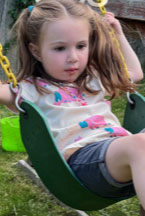Happiness: Time Without Aim
What is happiness? By what means do we know if we are happy? It seems that only in retrospect I judge myself to have been happy.
 My grand daughter is almost four years old. She appears to be as happy as is humanly possible when I push her high in a swing. While swinging she sings a fragment of a rock n roll song lyric over and over, “baby take me higher, higher”… I cannot remember how happy I felt at four years old. And soon enough, neither will she. Layer upon layer of experience is deposited into memory as we mature. The earlier material becomes a small percentage of the totality. And it seems that painful memories are more indelible than the pleasurable ones. Moreover the imagination conjures infinite desire, most of which are to be unfulfilled. I read somewhere: the crab of desire sticks it’s claws into our hearts, and the blue bird of happiness flies away. Who could disagree?
My grand daughter is almost four years old. She appears to be as happy as is humanly possible when I push her high in a swing. While swinging she sings a fragment of a rock n roll song lyric over and over, “baby take me higher, higher”… I cannot remember how happy I felt at four years old. And soon enough, neither will she. Layer upon layer of experience is deposited into memory as we mature. The earlier material becomes a small percentage of the totality. And it seems that painful memories are more indelible than the pleasurable ones. Moreover the imagination conjures infinite desire, most of which are to be unfulfilled. I read somewhere: the crab of desire sticks it’s claws into our hearts, and the blue bird of happiness flies away. Who could disagree?
Yet, there are times and places where we are certain, unaccountably we were happy!
Walter Kaufmann, Nietzsche’s translator adds this note to the poem.
Sils Maria is the village in the Upper Engadine in Switzerland where
Nietzsche spent his summers from 1881 until 1888, excepting only 1882.
He wrote Part One of Zarathustra in Rapallo, on the Riviera, early in
1883, and completed Part Two in Sils Maria that summer. The poem
suggests that the idea of Zarathustra himself “carne to him” in the
summer of 1881 and eased his lonesomeness, turning it into a twosomeness.
Sils Maria
Here I sat, waiting –not for anything —
Beyond Good and Evil, fancying
Now light, now shadows, all a game,
All lake, all noon, all time without all aim.
Then, suddenly, friend, one turned into two-
And Zarathustra walked into my view.